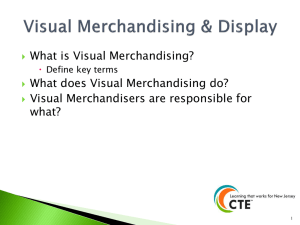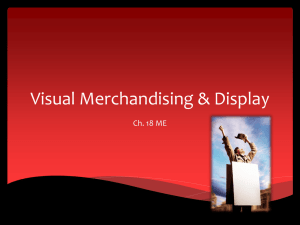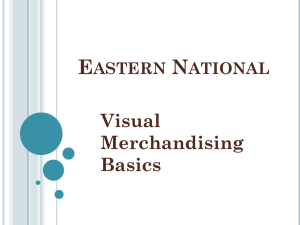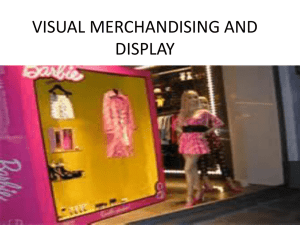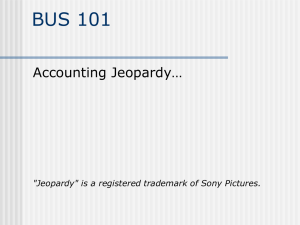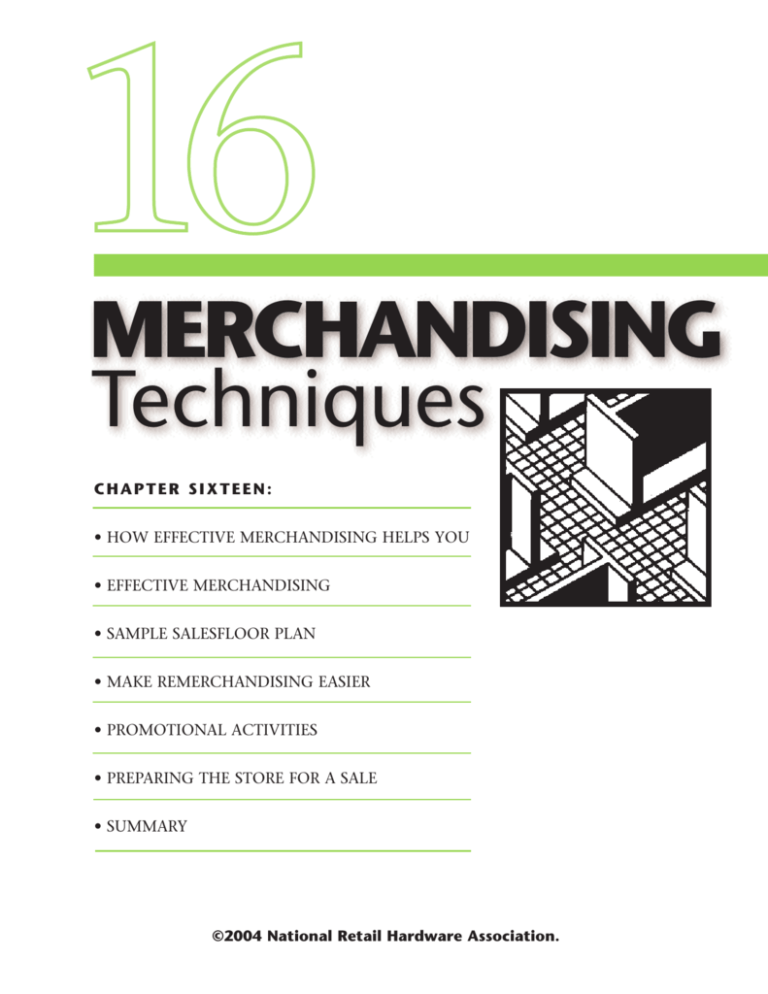
MERCHANDISING TECHNIQUES
16
MERCHANDISING
Techniques
CHAPTER SIXTEEN:
• HOW EFFECTIVE MERCHANDISING HELPS YOU
• EFFECTIVE MERCHANDISING
• SAMPLE SALESFLOOR PLAN
• MAKE REMERCHANDISING EASIER
• PROMOTIONAL ACTIVITIES
• PREPARING THE STORE FOR A SALE
• SUMMARY
©2004 National Retail Hardware Association.
MERCHANDISING TECHNIQUES
HOW EFFECTIVE
MERCHANDISING
HELPS YOU
By studying this chapter on merchandising and the products you sell, you can
help increase the entire store’s sales.
Studying can also help you personally—if
you practice what you learn daily. Good
merchandising:
Makes your selling job easier. Signs, displays and merchandise arrangements do
much of your selling job for you.
Frees you for genuine selling activities.
Effective merchandising encourages most
shoppers to serve themselves, thus freeing
you to help the big-ticket shopper who
really needs your help.
Increases your sales per customer. Even
when you serve a customer, an attractive
merchandise arrangement will stimulate
extra sales. This boosts your sales per customer, which makes your sales record run
well above the national averages.
Raises your total sales. You can only
wait on one customer at a time, but many
customers can serve themselves at the
same time from the displays you build.
Makes retail selling more rewarding.
Rushing around the salesfloor to make
small sales can be frustrating. Effective
merchandising frees you for activities that
challenge your selling skills.
Gives you time to develop new skills.
Self-service displays give you time to
involve yourself with other retailing activities, which increases the speed of your
raises, advancements and promotions.
These are only a few of the tangible and
personal benefits you gain when you
learn to be a good merchandiser.
■ SPECIFIC MERCHANDISING
SUGGESTIONS
Merchandising is not some mysterious
art only a few possess. Merchandising is
daily display activities that almost anyone
can do if he or she works at it.
The effective hardware store or home
centre merchandiser:
• Puts attractive displays, provided by
manufacturers and wholesalers, to work
for him.
• Uses effectively the many point-ofsale pieces he receives.
• Displays related merchandise together
for increased impulse sales.
• Features all advertised and promoted
items.
• Insures that all displays are neat, wellstocked and accessible to shoppers.
• Makes effective use of feature end or
end-cap displays.
• Builds attractive departmental displays with creativity and imagination.
• Prices all items consistently. Updates
all prices when they change. Makes sure
the store is as competitive as possible.
• Allocates space to each department in
line with that department’s sales.
• Identifies all departments with signs
or attractive decor or both.
These are only a few basic merchandising techniques that hardware stores and
home centres everywhere find highly
effective. Read Do-It-Yourself Retailing and
other magazines for merchandising ideas
and suggestions. Shop your competitors
and other kind of stores—supermarkets,
discount chains, specialty shops—to see
what they do right . . . and wrong. Shop
for display ideas you can adapt to your
own salesfloor.
■ RELATING SPACE
TO SALES
For maximum sales, the amount of
space a department occupies should relate
to the sales the department generates.
Sometimes a store owner or manager will
let his personal interests color his business judgment. Someone interested in
hunting, for example, will maintain a
large gun display although there is little
interest in the market. Keep in mind that
you should display what your customers
like.
If the store allocates too much space to
a department, total sales per square foot
drop. If the store allocates too little space,
it loses sales. The only way to know how
much space you should allocate is to routinely check the store’s record of sales per
square foot for each department.
■ SEASONAL EFFECT
ON SALES
The space a store allocates to a department must, of course, change constantly.
The seasons affect all departments of a
greater or lesser degree, and in some cases
the change is drastic. For example, the typical store sells virtually all seed and fertilizer
within about an eight-week period. The
most profitable stores allocate high-traffic
areas to seasonal merchandise, regularly
changing the display with the seasons.
EFFECTIVE
MERCHANDISING
Good merchandising is not simply an
attractive display. Merchandising, to be
effective, makes the entire salesfloor inviting. No store is well merchandised until
all areas of its salesfloor are appealing and
easily accessible to shoppers. Effective
merchandising demands:
A well-planned salesfloor. Assign every
department a specific display area.
Fixtures and accessories designed for
the merchandise they display. Stores waste
much space and lose sales per square foot
when you do not use the correct shelf
profile and accessories for each merchandise category.
Adequate aisle space. The best display
loses selling power if merchandise blocks
the aisles and shoppers cannot reach it.
Inviting displays. A display is more than
merchandise on a fixture. The items must
be clean, the display complete (which
means you have to restock the fixture regularly) and the backup stock nearby.
Attractive signs and decor. Signs and
decor serve two basic purposes: they create a buying and shopping mood and
encourage shopping, and they help direct
shoppers into all areas of your salesfloor.
A continuing, overall inviting shopping
atmosphere. The best display is destroyed
when it does its job—attracts shoppers.
Building an inviting shopping atmosphere
never ends. The only salesfloor that does not
NOTE: ALWAYS CONSULT YOUR PROVINCIAL AND LOCAL CODES
2
MERCHANDISING TECHNIQUES
require attention is one without customers.
Study hardware association material on
good display techniques. Read Do-ItYourself Retailing each month; the magazine runs pictures of displays from stores
around the country. And look through
manufacturer literature, a good source of
merchandising and display ideas.
■ EFFECTIVE USE OF
END DISPLAY
The displays at the end of each gondola
run, called feature ends or end caps, are
highly effective. As a rule, a feature end
will sell merchandise at least twice as well
as the same display in another location.
The effectiveness, however, depends on:
o The display’s attractiveness.
o The merchandise’s seasonal nature.
o Location in the store.
o Relationship to surrounding merchandise.
o Price.
o How well it has been advertised or promoted.
o Ease of accessibility.
In actual in-store studies conducted by
NRHA, some end displays have moved
merchandise up to eight times as fast as
an identical display just around the corner. Many manufacturers make special
feature end displays and Do-It-Yourself
Retailing offers suggestions on how to
build such units. Some basic tips: Don’t
crowd . . . Change often . . . feature promoted or seasonal items . . . and keep
them neat and clean.
One effective device is to surround an
audiovisual projector with the product on
an end display so shoppers can see how to
use the item.
■ AISLE SPACE
Never crowd the shopper by reducing
aisle space. Remember, no display is effective unless you leave room for shoppers to
see it. There are three basic aisles in a
hardware store or home centre:
Main aisles, where major customer traffic is routed. Normally limited to one or
two aisles from the front to the rear of the
store. Main aisles should be five to six feet
wide. If the store used shopping carts,
main aisles should be wide enough that
carts can meet and pass easily.
Cross aisles, that feed from main aisles
to each side of the store. They are normally four to five feet wide.
Secondary aisles, run from main and
cross aisles into all parts of the store.
They are usually three to four feet wide.
Display related merchandise on both
sides of an aisle, rather than around a
gondola where the customer can see only
half the merchandise at a time. Cross-aisle
merchandising makes any department’s
stock seem more complete.
■ EFFECTIVE USE OF
SHELF SPACE
Hardware stores and home centres do
not waste floor space nearly as often as
they waste shelf space on sidewall fixtures
and gondolas. Shelf space is wasted when
a store:
o Overstocks one item while understocking another.
o Fails to refill bins or shelves when the
basic stock is reduced.
o Stocks the same items in several places.
o Uses the wrong shelf profile.
o Does not relate shelf space to customerdemand fluctuations.
You can increase your productivity
greatly—and your value to the store—as
you learn to use shelf space properly.
For example, it is more effective to merchandise vertically. That is, display similar
goods up and down, on perfboard and
shelves, rather than stretching them out
along a gondola. The shopper can stand
in one spot and pick what he wants. The
display is more attractive and it is a lot
easier to reorder and restock.
Two exceptions to this advice: Pipe fittings are best displayed horizontally by
diameter, vertically by type—Ls and Ts.
Also, display bolts this way, horizontally
by diameter, vertically by length.
■ WALL-FIXTURE
PROFILES
Although the shelf profile is only one element in effective display, it is an important
one. If you use the wrong shelf profile, you
cannot build a display that will generate
maximum sales. The way the shelf is placed
on the fixture is only one element in successful merchandising. How you arrange the
merchandise on the shelves is also important. Three quick tips:
Show as much as possible. Most large
stores try to avoid backroom stock.
Display the most profitable items
between belt and eye level.
Never display a single item. Use the
“good, better, best” approach so the shopper has a choice of quality.
Adjust the shelves for the merchandise
they display. If they are too far apart you
waste space and the salesfloor looks
understocked. If shelves are too close
together or not set back properly, the
shopper cannot see merchandise on the
lower shelves without bending over.
■ GENERAL DISPLAY
SUGGESTIONS
Here are some general tips: First, a pyramid profile, widest shelves at the bottom,
lets the shopper see the most merchandise. Shelves the same width, however, are
best to mass display items the same size
and shape.
Second, never place shelves so close
together that the top shelf hides binned
or boxed merchandise on the lower
shelves. Shelves are for display—not for
storage. And no top shelf should ever be
wider than those below except on a sidewall or gondola over six feet high where
the shelf is in fact more for storage than
for display.
■ POINT-OF-SALE SIGNS
If you could stand beside a wellplanned display that was loaded with
attractively priced seasonal merchandise
and ask each shopper to buy, you would
sell many of the items every day. You cannot do this, of course, but a good pointof-sale sign can. It may not audibly ask
for the purchase, but if done well it will
stimulate extra purchases. An effective
point of sale will:
o Attract the shopper’s attention.
o Identify the item or service offered.
NOTE: ALWAYS CONSULT YOUR PROVINCIAL AND LOCAL CODES
3
MERCHANDISING TECHNIQUES
o Describe what the item will do for the
shopper.
o Give the price and any savings.
should do every night or the first thing
you should do every morning is move
packages to the front of the shelf; make
your displays look full and neat.
■ VALUE OF DECOR
Decor is more than signs. If done well,
decor will stimulate buying. Decor creates
a favourable impression of your salesfloor,
but it need not be expensive or elaborate.
You can create a buying atmosphere with
low-cost symbols if you select and position them correctly.
Money you spend for good decor is an
investment; it makes your store distinct,
attractive and a pleasant place to shop.
■ USING DEPARTMENTAL
SIGNS
Departmental signs are different from
decor and point-of-sale signs. They should
be a regular part of your merchandise
arrangement. They help any store, but
they are essential on any salesfloor that is
5,000 square feet or larger.
■ BASIC MERCHANDISING
RULES
Here is a summary to help you remember some of the basic rules this chapter
discussed:
o Display slow-moving and low-priced
items farthest from the customer’s
reach.
o Always use prime display space for
high-demand, seasonal, impulse, or
promotional items.
o Use point-of-sale signs to call attention
to hot items in each department.
o The best selling height on any display
is between eye and belt level.
o Action, light and colour attract attention to any display.
o No display is fully effective or complete
until the merchandise is priced. And
not only must the items be priced, but
the prices must be consistent.
o If feature displays do not blend with
other displays around them, they may
repel rather than attract.
o Keeping displays neat and well stocked
is one of the most effective “tricks” in
merchandising. The last thing you
SHOP CONCEPTS
If space on your salesfloor permits, you
can build store traffic and sales by using the
shop concept in certain sections. Both garden and photo shops have proven especially
effective. A shop is a setting which shows
the way the items are used in the typical
home. Shops add colour, interest and build
sales and your store image.
Shops sell more than merchandise; they
sell ideas and the desire to own. By simulating a home setting, shops encourage a
buying decision that might be made later
. . . on someone else’s salesfloor.
SAMPLE SALESFLOOR PLAN
See page 5 for an example of a salesfloor plan. It presents a format called a
“loop” layout. It is not typical, but there
is no such thing as an average store—nor
should there be. Every salesfloor is different because every store carries different
merchandise, sells to different consumers
and serves a different community. This
plan illustrates many of the good merchandising principles this chapter discussed and several new merchandising
concepts. Study it.
Put some of the ideas to work on your
salesfloor. Improve on these basic ideas by
adapting them to your store’s needs. Note
the width of the main aisles and cross
aisles. Consider the plan from the shoppers’ point of view. Think of the way the
traffic flows around the store. You may
not sell what you should in a given
department simply because very few people pass through it.
This plan makes it easy to move merchandise onto the salesfloor, into shopping carts, to the point-of-sale terminal,
and into the customer’s car. The plan will
help you pick up ideas to improve your
salesfloor’s efficiency and selling efforts.
MAKE REMERCHANDISING EASIER
An effective salesfloor is not attained—it is
maintained. Since the merchandise you sell
and the market and shoppers you serve
change continuously due to changing needs
and interests, it is obvious that you must
remerchandise your salesfloor often. This is a
tremendous chore, but when you plan carefully and approach the job in an organized
way, you can do it with a minimum of effort.
Here are five rules:
o List all improvements to be made.
o Assign a priority for each job to be done.
o Secure the merchandising aids you need
to do the job.
o Advise everyone in the store what you
plan and how they may be involved.
o Make each remerchandising project
a merchandising training session—
and practice good merchandising
techniques.
PROMOTIONAL
ACTIVITIES
Although hardware stores and home centres are not as promotional as many retailers,
there is no reason why they cannot be—and
the most successful promote regularly.
Why promote at all? Because you want
to attract more people to the store than
would come without the promotion. You
are trying to do two things: maintain
your average sale per customer and
increase the number of sales. The more
shoppers who visit your store, the more
you will sell.
What can a promotion do? A wellplanned sale or promotion:
o Can gain new customers for the store
o Will encourage repeat sales.
o Can counter a competitive move.
o Will introduce new or improved products.
o Can capitalize on seasonal or geographic
advantages.
NOTE: ALWAYS CONSULT YOUR PROVINCIAL AND LOCAL CODES
4
MERCHANDISING TECHNIQUES
SAMPLE SALESFLOOR PLAN
NOTE: ALWAYS CONSULT YOUR PROVINCIAL AND LOCAL CODES
5
MERCHANDISING TECHNIQUES
o Can reduce excess inventories.
o Can create enthusiasm among the
store’s salespeople.
A promotion—no matter how well
planned—cannot:
o Turn overpriced merchandise into profitable volume.
o Overcome the impression of a dirty, disorganized store.
o Compensate for inadequate advertising.
o Reverse a downward sales trend for any
length of time.
o Overcome an inadequately trained salesforce.
■ PROMOTIONAL
OBJECTIVES
Retailers sometimes confuse advertising
with promotion. Advertising is calling favorable attention to your store and the products
you sell. The ad announces the promotion—
the Anniversary Sale or the Summer-End
Sale—it is not the promotion itself. Before
any promotion, there are a number of questions you should answer.
What are the promotion’s specific
objectives? What are we trying to accomplish? Build traffic? Clear out end-of-season merchandise? Establish the store as
the place to buy hard-to-find tools?
Announce a new location?
What specifically is the promotion
expected to do?
Who is the target?
What is the competition doing?
Is there a seasonal aspect?
How long ago was the last promotion?
■ WHAT PROMOTIONS
CAN WE RUN ?
A hardware store or home centre has a
number of promotional opportunities that
many other kind of retailers either do not
have or are not organized to exploit.
For example, you can run a do-it-yourself
consumer show. You can offer clinics on
minor electrical repairs, plumbing repairs,
redecorating, and other subjects. You can
demonstrate new products and new uses for
old products. Many people—especially
women—find a hardware store intimidating, and unless a shopper knows how to use
a product, he or she will not buy it.
PREPARING THE
STORE FOR A SALE
Your salesfloor should create a sales atmosphere. Make it easy for shoppers to identify
the advertised specials with attractive signs
and features display. Use departmental signs
so customers can find what they want without bothering you for simple directions. A
good ad can be wasted if a shopper cannot
find what he wants or if the salespeople are
unprepared or rude.
Clear all the aisles and leave them wide
enough for shoppers to browse without
bumping into each other.
Remember that customers do not really
want products. It’s the old joke: No one wants
a drill, but everyone wants a hole. Your advertising will attract two kinds of shoppers, both
of whom want a hole; however, the first kind
of shopper knows what he wants—he wants
fast service. He does not demand a lot of conversation and you can serve him best with
complete, well-marked displays.
The second kind of shopper needs help.
Your promotion attracts him to the store, but
he needs help to select the right size, type or
model to buy. You serve this customer best by
providing courtesy and product knowledge.
How else can you prepare the store?
Give shoppers a chance to review your
offers with ad reprints as they enter. Put a
copy in their bags as they check out. Not
everyone who comes into the store during
the promotion knows you are having one:
Tell them about it. Give shoppers a copy
of your ad and encourage them to return
for an item they have overlooked.
Help featured items get more attention with
a counter card that jumps out at a shopper. A
bold headline—”As Advertised” or “Featured
Item”—should dominate the card with the
item’s price, the savings involved, and if space
is available, the item’s picture as it appeared in
the ad. Make one for each featured item. It
gives you a professional look at little expense.
Everyone likes to save money. A sale
price draws customers into a store; however, many “sales” are a deception. The
items are not specially priced. Customers
have learned this and have become skepti-
cal of the “bargains” some stores offer. To
help protect your store’s reputation:
o Put a “Sale” tag on every reduced item.
o Show the regular price and the sale
price so the shopper can see what he
saves by buying during the sale.
o Be sure sale price offers a genuine savings.
o Make sure that identical items carry
identical prices. When a shopper finds
three different prices on the same product, he wonders about the store’s professionalism at the very least . . . and
the store’s morality at the worst.
■ SET UP WINDOW
DISPLAYS
To make shoppers and passers-by aware
of your promotion, display your ad and
the featured item in your store window,
when possible, setting up the display
before the ad runs.
■ PREPARE YOURSELF
FOR THE SALE
People make the difference between a
successful sale and a flop. The store is not
ready for a promotion until every salesperson knows what is advertised. They
have to know where the item is located
on the salesfloor, its regular price and its
sale price. And even more important, they
have to know how the value of a sale item
compares to a comparable item at a regular price.
The shopper may come to the store to
look at the 1/4” drill you advertised, but
he may really need a 3/8” reversing drill.
The salesperson does the customer and
the store a disservice if he does not point
out the more expensive drill’s benefits. At
the same time, he does not criticize the
drill on sale, and if the customer decides
that is the drill he wants, that is the drill
he is sold.
But to help customers find the best buy,
the salesperson has to know as much as
he can about all the products the store
sells. Read literature, study product tags,
listen to what shoppers say about products, and read all you can about new
products in the trade press.
NOTE: ALWAYS CONSULT YOUR PROVINCIAL AND LOCAL CODES
6
MERCHANDISING TECHNIQUES
■ PRESALE MEETING
A week before any promotion begins
there should be a meeting with all the
employees, even those who do not work
on the salesfloor. The more everyone
knows about the event the more successful it will be. Also, someone unexpected may come up with a valuable
suggestion.
At the store meeting you should:
o Find out about the promotion, its goals
and objectives.
o Get a list of advertised items, regular
and sale prices, and location in the
store.
o Find out what times you are to work
and whom you are working with.
o Find out when your area needs to be
ready and what you are expected to do
in your area.
o Get any special assignments such as
window displays, point-of-sale materials
and store decoration you might have.
The goal, as always, is to let everyone
know that the store is running a promotion,
why it is running this promotion at this
time, who is responsible for what, and what
merchandise is going to be on sale.
■ BUILD DISPLAYS OF
FEATURED ITEMS
Retailers sometimes ask, “Do ads really
sell merchandise?”
The answer is probably, “No.”
Advertising creates an interest in, or a
desire for, merchandise—but this interest
only brings the customer into the store
where he can examine it. The merchandise usually sells itself.
You can help it sell itself when you display it clearly and attractively. An attractive display of advertised items:
o Helps the shopper who saw it in the ad
find it quickly and easily.
o Saves you time and effort in helping
shoppers locate the item.
o Lets the shopper who did not see the ad
know that the item is an advertised special.
It is always good to display related
items together . . . even when no one
item is on sale. This tends to increase
impulse sales. The shopper who comes in
for paint may pick up a brush or the
shopper who comes in for a fuse may pick
up a dimmer switch. When you display
related items together in the same general
area you:
Let the shopper compare the sale item
with those of different types and quality.
This helps him understand that the sale
item is really a bargain.
Encourage the shopper to buy nonadvertised items. In many cases, a store
makes little or no money on the advertised items. If the shopper buys only the
advertised product, the store probably
makes no profit on the sale. But when
you sell other items at normal margins
you make the promotion pay off.
Do the shopper a favour. In many cases,
the sale item, even though reduced in price, is
not the shopper’s best buy—when you display
related items with the advertised special, you
help him make the best choice.
■ REPRICE AND RESTOCK
A sale is not a sale unless the items
return to their regular price after the
event. You have deceived a shopper who
comes in to the store for a week-end special if he can buy the item at the same
price on Monday. When you fail to
reprice at the end of a promotion:
o You cheat those who bought during the
sale.
o You reduce the store’s credibility in the
eyes of the shopper.
o You hurt the store’s profits and shoppers do not appreciate the low prices.
Repricing after a sale is a chore, but is
absolutely necessary.
As is the restocking of shelves. If your
promotion has been effective, your stocks
are low or totally exhausted. Your display
is disarranged.
If you do not bring stocks back to normal, with merchandise rearranged,
repriced, and, in some cases, moved back
to its regular location, the store can end
up losing more profits and customers’
respect than the promotional effort produced. Think of it, perhaps, as cleaning
up after the party: often, the better the
party, the more you have to clean up.
■ FOLLOW UP AFTER
THE PROMOTION
After every promotion there are a few
things that must be done, follow up on all
rain checks to make sure that every customer who wanted a sale item is able to
buy it within a reasonable time. And if
you cannot obtain the same item, offer
the customer a comparable item at the
same sale price. The money you may lose
on these few sales, returns to you a hundredfold in customer goodwill.
Ads and promotions are sales assists. If no
shoppers come into the store, you and everyone else on the sales team will be out of work.
Shoppers generate sales, sales generate profits, profits generate jobs. Since the store
depends on profits for its existence, and since
profits depend on sales, it follows that the
store’s existence depends on shoppers.
Think of a sale or promotion as a merchandising party—your advertisements
are invitations to people in your community to come to the party. It is rude to
invite someone to visit and then not
make him welcome when he accepts the
invitation. In social circles this make you
an outcast. In business circles it makes
you a failure.
SUMMARY
Customers have many choices when
they think of buying something. The
merchandise is seldom the primary reason a shopper selects a particular store.
Many consumers, for example, do not see
any difference between a home centre
and a discount store; they tend to see
home centres as a specialized discount
store. One of today’s challenges is to
make hardware stores and home centres
look and feel different from discount
chain stores.
Don’t be afraid to be creative. Do make
your salesfloor and your store an easy,
pleasant place to shop. In the next
decade the standard performance of the
20th century will not be acceptable . . .
and the outstanding performance will be
only average.
NOTE: ALWAYS CONSULT YOUR PROVINCIAL AND LOCAL CODES
7
CANADIAN IMPERIAL AND METRIC MEASUREMENTS
Canadians generally use a
mixture of measurement units.
Liquid volumes are typically
based on the metric (SI) system. Temperatures and distances are commonly specified
using metric terminology.
Weights, depending on the
type of product, use either the
metric or Canadian Imperial
system. Lengths and dimensions of construction products,
particularly for residential use,
are generally in Canadian
Imperial measurements. And
many of the products we use
are manufactured in U.S.
measurements—several of
which differ from Canadian
measurements.
Canadian building codes are
written using metric units. But
the construction trades, particularly those in residential construction, typically use the
Canadian Imperial system.
This mixture of measurement
systems frequently results in
many product manufacturers
providing information using
both systems. Unfortunately,
the approaches used in pre-
senting the “converted” measurements are not consistent.
Some information is based on
“exact” conversion measurements, whereas other information is based on “rounded”
measurements.
From your perspective and in
communicating with your customer, it is important to recognize that in some instances the
exact conversion is necessary
and in other instances a more
“rounded” conversion is
appropriate.
CONVERSION FACTORS
1 inch (in.)
=
25.4 mm
32 fluid ounces - US (oz.)
=
1 US qt.
1 foot (ft.)
=
0.3048 m
40 fluid ounces - Canadian (oz.)
=
1 Canadian qt.
1 yard (yd.)
=
0.9144 m
1 mile (mi.)
=
1.609 km
1 fluid ounce - US (oz.)
=
29.6 mL
1 fluid ounce - Canadian (oz.)
=
22.8 mL
236mL
1 ounce - avoirdupois (oz.)
=
28.35 g
1 cup - US (cup)
=
1 pound - avoirdupois (lb.)
=
0.454 kg
1 cup - Canadian (cup)
=
227mL
1 quart - US (qt)
=
0.946 L
1.136 L
1 pound per square inch (psi)
=
6.895 kN/m2
1 quart - Canadian (qt)
=
1 pound per square foot (psf)
=
0.04788 kPa
1 gallon - US (gal.)
=
3.785 L
1 gallon - Canadian (gal.)
=
4.546 L
Celsius temperature = (Fahrenheit temperature - 32) / 1.8
SOME TYPICAL MEASUREMENTS FOR HARDWARE AND FASTENER PRODUCTS
(“rounded” conversions)
Length
in.
1
/32
1
/8
Length
3
/8
1
/2
5
/8
3
/4
Length
Weight
in.
0.8
1 /8
3.2
1 /2
38
60
1.5
10
3.0
10
4.5
6.4
2
51
72
1.8
12
3.7
50
22.7
9.5
4
102
84
2.1
18
5.5
100
45.4
12.7
12
305
90
2.3
25
7.6
750
340
15.9
18
457
120
3.0
50
15.2
1250
567
3
mm
in.
m
ft.
m
lbs
kg
35
48
1.2
7.5
2.3
1
0.45
1
1
/4
Length
mm
19.1
24
610
156
4.0
75
22.9
1900
862
/8
22.2
30
762
216
5.5
100
30.5
2650
1202
1
25.4
36
914
312
7.9
5000
2268
7
NOTE: ALWAYS CONSULT YOUR PROVINCIAL AND LOCAL CODES
8
ACKNOWLEDGEMENTS
The course was first developed by the North American Retail
Hardware Association (NRHA) and the Home Center Institute (HCI)
under the direction of a project coordinator and a number of
authors. Several U.S. based companies provided industry specific
information.
This second Canadian Edition of the ACHR is based on NRHA/HCI’s
14th Edition. It has been extensively modified and rewritten with
the help of Carl R. Wilson & Associates Ltd. (CRWAL) so as to
reflect Canadian products and construction practices. We also
acknowledge the many Canadian organizations and companies
that provided information for this Canadian edition of the
Advanced Course in Hardware Retailing (ACHR) and the Building
Material Product Knowledge Course (BMPK).
Because local codes and regulations vary greatly, you are reminded
to check with local experts and authorities on which codes,
regulations and practices apply in your area.
Copyright© 2004 by NRHA. All rights reserved. No part of this
publication may be reproduced, stored in a retrieval system, or
any system, or transmitted in any form or by any means, electronic,
mechanical, photocopying, recording or otherwise, without
prior written permission of the publisher.
Though the information in this course is intended to be
accurate and useful, the authors, editors, publishers,
CRHA and CRWAL and their directors, officers, agents
and employees will not be liable for any damage whatsoever that might occur from any use of this material.
NOTE: ALWAYS CONSULT YOUR PROVINCIAL AND LOCAL CODES
9


